This posting is dedicated to my dad, Keith Miller. Dad, you fought in Europe, not SEAsia and thankfully you were not a POW. But you experienced war and hunger and fear, and those experiences were life-changing for you. I have never known hunger and fear and war, and I owe that and my ability to travel freely and witness these sights to you.
I’ve not read the book, nor seen the movie, but the “real” Bridge on the River Kwai is a potent reminder of human cruelty, and what our world might have looked like had the outcome of WWII been different.
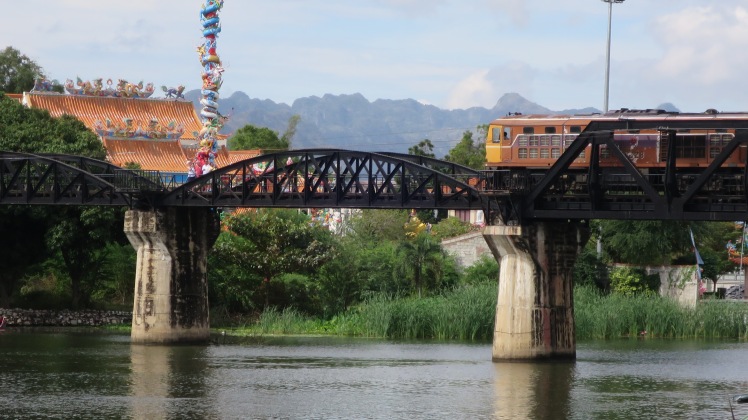
The Bridge on the River Kwai is located in the town of Kanchanaburi, which has built up a large tourism business around the bridge, the War Cemetery, the JEATH museum and the war museum.
We stayed for four nights at the Thai Garden Inn, across the river from town (the quiet side). This has been our home for the past four days – a relaxing respite.

Our first night, we ate at a riverside restaurant just down the road. Walking at night is tricky; there are no shoulders and most drivers are quite unconcerned about pedestrian safety. Apparently it is up to us to stay alive. This was our first dinner – worth remaining alert for:
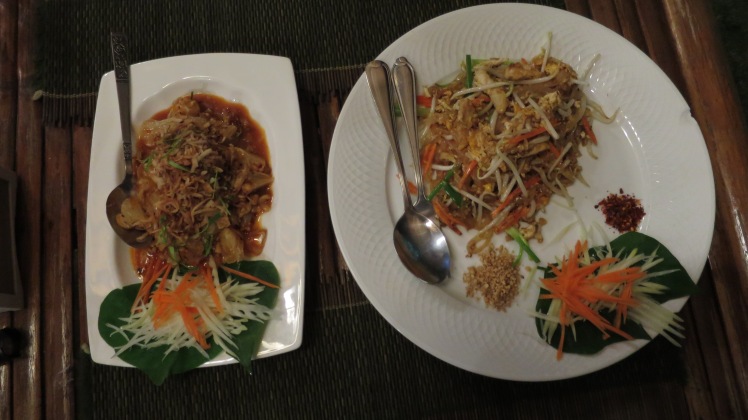
The next day, we walked about 15 minutes to the entrance of the bridge. The railway from Thailand to Burma was built in 1943 to provide a secure supply route for the Japanese to make their way to India, as the sea routes were too risky. It was a total of 414 km., with 294 km. in Thailand, built entirely by Asian forced labourers and Allied POWs. It became known as the Death Railway, as over 13,000 prisoners and 93,000 Asian labourers died during its construction. The bridge was built with 11 steel spans, and the rest were wood, and when the Allies bombed it in 1944, three spans were destroyed. There are frequent pullouts to stand on for safety, as a tourist train crosses it twice daily. Luckily, we arrived quite early, and had the bridge almost to ourselves.

Looking over the River Kwai from a pullout.

The JEATH museum is just down the road from the bridge – JEATH is an acronym for Japan, England, Australia, America, Thailand and Holland – representing the Allied POWS and Asian forced labourers involved in the building of the Thai-Burma Railway.
This is a section of the original track over the bridge.

The JEATH Museum is difficult to go through. The savagery and tragic loss associated with this infamous railway are portrayed through life-size dioramas, photos and artifacts, and they grab you by the gut. This railway car is typical of how POWS were housed on their way to the camps.

Japanese soldiers watching over the POWs.
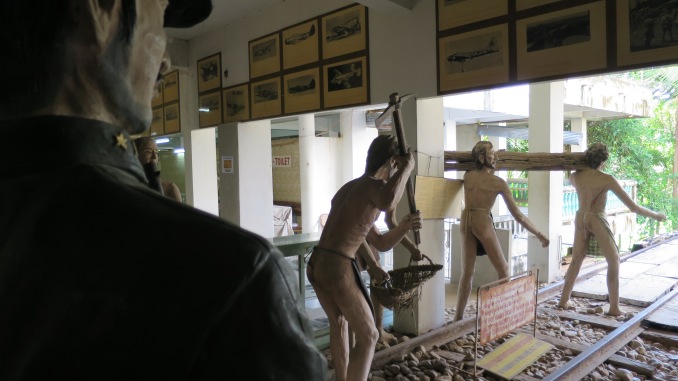
A poignant and understated expression of the futility of war

Off we went to the War Cemetery. We had never visited a war cemetery before – there is nothing to celebrate here.

The grounds are immaculate and beautifully cared for – a team of gardeners steadily at work weeding and planting and grass-cutting. The markers are identical, but for the names, ages, ranks and sentiments of loved ones. 6,982 Australian, Dutch and British POWs are laid to rest here, including two graves with the cremated remains of 300 soldiers.

It was a moving and emotional experience to walk the rows and note the young ages and wonder who they left behind. Loss magnified many times.
Then, the most extraordinary thing happened. Three young girls started taking selfies – laughing, posing, all pouty lips and peace signs. It was beyond disrespectful. Young people might not understand the importance of a memorial or a monument – they are many generations removed, but it seems impossible to think anyone of any age would enter a cemetery and consider it just another backdrop for a selfie. Stephen spoke to them, asking them please not to take selfies. They didn’t understand his words, but I think they got the message.
Yesterday, we headed up to Hellfire Pass Memorial – an 80 km. bus ride out of Kanchanaburi, up to the site of some of the most difficult rock cuts of the entire rail line. Hellfire Pass is so called because the light from the torches bouncing off the limestone and quartz rock illuminated the skeletal workers as they laboured at night – a scene from hell.
We began by visiting The Memorial Museum, which thoughtfully goes through the timeline of the railway construction, and outlines a number of written accounts from POWs who survived, as well as harrowing photos of those who did not.
The museum and clearing of the old rail site at the cuttings was the dream of an Australian, Tom Morris. He was a POW for three years, and incredibly decided to return to the site of his torment in 1984. It was his desire to restore the area as a memorial to all who perished there, and with the help of the Australian government, he instigated the building of the museum and the restoration of the walking trails. Another Aussie POW, Peter Rushforth, who became a potter after the war, created the Peace Vessel as part of the display.
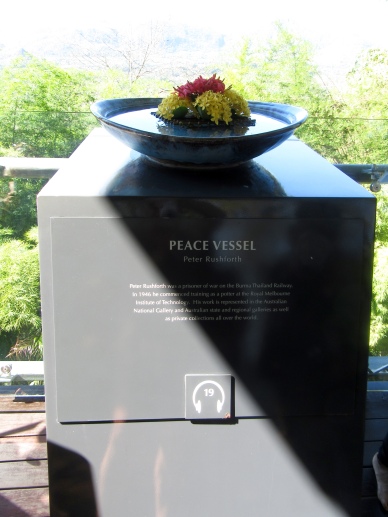
There was an excellent audio accompaniment to the walk, with first-person accounts submitted by former POWs. What really struck me was the ability of these men to survive after such brutality. One POW, who is a painter, told of his visit to the area decades later. During the war, the beauty of the mountains and the spring flowers had been enough to keep him going, and it was always his intent to return and paint those scenes. The photo below is of the valley and mountains beside the rock cut. Burma is just 40 km. away.
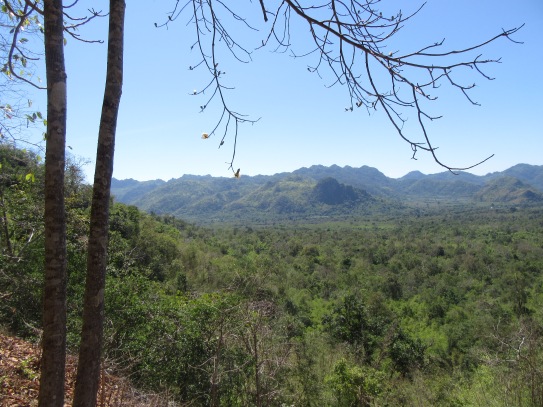
We began our walk with food in our belly, water in our backpack and shoes on our feet. It was hot, and the going was a bit rough, but we were reminded of the conditions the POWs lived with and perished from. In this particular cut, they had to walk from their camp, which was 6 km. away. They slept on bamboo cots, and were often covered in lice and fleas. They were fed one cup of rice a day and very little water. Many of them had dysentery, cholera and malaria, and when they fell down or could not move fast enough, they were beaten, sometimes to death. They worked 16-18 hours a day under blistering sun, and under constant threat of abuse and beatings from the Japanese guards. As the war progressed, and the urgency for the railway line increased, the abuses grew worse. By the end, over 13,000 prisoners died of illness, malnutrition, and torture.
This section of the cutting was achieved by a tedious method called “Hammer and Tap”, which involved hammering out pieces of rock and breaking them down. This section is 73 metres long, and 25 metres deep – dug entirely by hand through jungle vegetation from the top to what became the railbed. If you look to the left of the cut, you can see flags and crosses – one of a number of shrines and memorials along the way.

Most of the railway was dismantled after the war, but this small section of rail remains as part of the memorial.

This was an extremely impactful experience, and I hope the pictures help to tell the story.
Very powerful description and photos. Thank you.
Eveline
LikeLike
Thanks Eveline – this was my first encounter with WWII sites, and such vivid depictions of suffering.
LikeLike
Thank you, Ginny. Very moving post. Thank you for taking us there.
LikeLike
thanks Shelagh – I know you have seen similar things in your travels – the impact never lessens.
LikeLike
Civilization is merely a thin layer on the human condition. Only our conscience/moral compass exists to prevent such outrage against others. War brings out the worst in people. Museums like this remind us of the lives lost and the commitment we must have to prevent further outrages like this.
LikeLike
I agree Roy. What is it that keeps us civilized? What is it that tips that balance? War also brings out the best in people, but I hope never to have to witness that moral dilemma.
LikeLike
So well written Ginny. It was if we were there with you. You may recall my same feelings being written about when we visited the war museums in Vietnam and the Killing Fields in Cambodia. Had the same at the Concentration Camps in Europe. Just a sick feeling in your gut that cannot be relieved because of the fact it is still going on……how is such cruelty possible and we never ever learn! One day we will be visiting museums and memorials in Syria, Iraq, Africa and be asking the same questions. So futile! As the old folk song goes “when will they ever learn, when will they ever learn”…..
Good for Stephen to speak to those silly girls, it must have felt like a slap in the face to witness such disrespect.
On a happier note, love your cute little place.
LikeLike
Oh my goodness, your photos of Vietnam and the Killing Fields were horrific. When will we ever learn? I don’t think we will. Well, WE will, but there will always be evil and inhumanity in the world – I’m convinced of that.
LikeLike
What a heavy and somber post this morning Ginny, it must have been very difficult to choose the right pics and words to describe the horrors. I have read many accounts and books on the subject but find myself in tears every time. How many wars will it take for men to understand that fighting is not the solution to conflict resolution, I despair!
My thanks go to those men who came back to the site to erect monuments to make us remember and to you for sharing this awful part of our common history.
LikeLike
Oh Laurence – the tears are always there – every Remembrance Day and in this case, with the photos and descriptions. What choked me up were the voices of the survivors, years later. I’m quite sure they did not “survive” unscathed, but they found a way to make a life and even to thrive. It is very inspiring.
LikeLike
Just subscribed to the blog. Looking forward to sharing in your adventure.
Watched the movie “Railway Man”, this week. It is the story of POW Eric Lomax and talks of his experiences on this very section of the railway. Having seen his story makes your account all the more touching.
This place reminds me of the extent of man’s brutality and the strength of his spirit.
LikeLike
Hi Marc
Thanks so much for subscribing – we’re glad to have you with us! I’ve never heard of Railway Man – thanks for telling me about it – I’ll try to watch it when we’re back in B.C.
Brutality and strength in the face of it – that is what is so incredible.
LikeLike
thank you for taking us with you to see and feel the horrors of that part of history so heart breaking to imagine. You write clearly with such honesty and insight. I have just read a book ‘The Colonel Of Tamarkand’ by Julie Summer – the story of her uncle who was right there – absolutely worth reading
LikeLike
Thanks for this post Ginny. I had two uncles who were captured in Singapore, one died in a Japanese prisoner of war camp, the othe in a Japanese ‘hell ship’, which was torpedoed. They were written about in a book called the Forgotten Highlander, by Alister Urquhart, who survived working on the Bridge on the river Kwai and survived the ‘hell ship ‘ that my uncle was on.
To bad we haven’t learned from our past wars, still so many young lives still lost.
Safe travels,Joy
LikeLike
Joy, I wonder if that book is easily available – I’d love to read it. How old would your uncles have been – I guess in their teens or early 20s?
Did your family talk about them much to you?
LikeLike
Hi Ginny, the boys were the youngest of 12 children, both in their early twenties. My mother always had framed pictures of them out on display. The book is still available,
LikeLike
Very sad to know this horrible time among so-called ” Humans “, happened. Seen the film, but of course it does not describe the real horrors perpetrated by the Japanese. My own Dutch Stepfather, whom my Mother met in Brasil in the early 50’s, had been a Japanese Concentration Camp Prisoner, for over 4 years, from ’41 to end of Pacific War in mid-’45. He had been working as a Plantation Manager in Java from the early ’30s on…An intelligent, educated and refined man, who after this experience, was , at times, while suffering bouts of the effects of Post Traumatic Disorders, a wreck of a human being. An otherwise wonderful person, for the rest of his life, suffering endlessly from these horrible episodes…, nightmares of the tortures, the death of many working colleagues at the Concentration Camp, endless hunger and disease memories… Yes, it was not easy for him, nor for my Mother and I to witness his, impossible to run from, periodic miseries.
War is a despicable activity. Sometimes it can be justified , if there is no other way of avoiding it, when the aim is to liberate Europe, for exp., from the Oppression of the Nazi terrifying occupation. Otherwise, never !
keep safe and happy further travels, my friends!
Lis
LikeLike
Oh Lis, what a tragic story. I wonder if doctors even knew how to identify and treat PTSD in those days, and how in the world did any soldier leave the war in one piece, much less a POW?
How sad for you all – how does one reconcile such awful things?
LikeLike
Beautiful and poignant. Thank you so much for taking us with you. Love to you both xo
LikeLike
Thanks Donna – I appreciate you saying so. xo
LikeLike
I’m sure it must have been emotional for you to write this post compared to the ones in the past. I know it was heart-wrenching to read. How little we really know about the horrors of war and how much we owe to those who came before us for our freedom.
LikeLike
It was hard to write about it, I must say, because you want to find the right words that describe it without trivializing it. Needless to say, even with seeing the memorial, I don’t have the foggiest idea of what they went through.
Not to be flippant, but we’ve always joked that I would sell out my own children at the first sign of real torture – a stoic I am not.
and yes, I have a very much enhanced sense of gratitude to my dad and to all who fought for us.
LikeLike
Fascinating stories about an atrocious war!!
Well done, hopefully you will move on to more pleasant sites in Thailand, how about Phi Phi Island, great snorkeling there!!
LikeLike
thanks Danielle. Well, we’re not going south, unfortunately, as those poor people have had catastrophic rains and flooding, with very little end in sight. It has been a disaster for them, with loss of life and property, and of course, a write-off for the tourism season for a while.
LikeLike
Thank you Gin. Very moving. You are bringing important history back to use all.
love gin
LikeLike
thanks Gin. The bridge, memorials and museums are definitely a beautifully-done tribute to the lives lost, and the suffering endured.
LikeLike
Dear Ginny, Thanks for the dedication in your ‘River Kwai’ blog, but what I went through was a
walk in the park compared to what those poor devils suffered. We only had to try to dodge
bullets and didn’t have to catch & eat rats for protein, though stew made from dehydrated Aussie
mutton probably wasn’t much tastier! Anyway, thanks Gin & keep ’em coming. Love, Dad
LikeLike
Dear Dad
We are all very thankful (you more than us, I can imagine), that you were not a POW. But you still dealt with war when you were a teenager, and you had to deal with the aftermath as an adult.
I’m guessing that eating dehydrated mutton was not the worst thing you experienced. Here’s a thought for you, Dad – finding affordable decent red wine in Thailand is a bit of a challenge, so we’ve been drinking Chang beer (delicious). That is my current hardship – not having a glass of red wine. You helped to provide a world where that is my biggest issue. Love Ginny xoxo
LikeLike
Thanks, Ginny. Keeping these truths alive is an inherited responsibility we all share. If we don’t, we stand to lose the meaning of our past but also our future. Thank you for sharing this provoking story board and inviting each of us the opportunity to reflect and pay thanks to those that have gifted us with the freedoms we have today.
LikeLike
Hi Jen
Thanks for your comments – very much appreciated. It is increasingly obvious that we can’t take world peace for granted anymore. I remember growing up and Reading The Diary of Anne Frank, and thinking how lucky we were that that was “history” and would never happen again.
You are right about our future – its security is not a sure thing.
LikeLike
Ginny and Steve, I knew a man who lived the experience you were visiting. He went on to head a major Canadian endeavour that ultimately required him to deal with Japanese businessmen 25 years later. He had to resign his position, he found it so unbearable meeting with his generation of Japanese who may have been among his or others’ tormentors. He did his best to leave behind the hell he was cast into, but ultimately could not shake the ghosts of his past.
LikeLike
Oh I can understand completely how that would affect him. I think there are just shades of resilience that POWs are capable of – I can’t see how it is possible to have those experiences and put them behind to live an otherwise normal life. Once you have experienced what humans are capable of, I don’t know how you find trust again.
LikeLike